Showing Spotlights 729 - 736 of 2780 in category All (newest first):
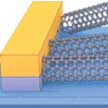 The detection of carbon monoxide (CO) in the air is a vital issue, as CO is a highly toxic gas and an environmental pollutant. Carbon monoxide is poisonous because it blocks the binding site for oxygen in hemoglobin. It is exactly this principle - a porphyrin ring with a central iron or cobalt atom that the poisonous gas attaches to - that can be used to implement sensors to warn against carbon monoxide. While carbon monoxide sensors have been extensively researched and commercialized, none make use of a molecule that can be voltage-activated using a newly reported method.
The detection of carbon monoxide (CO) in the air is a vital issue, as CO is a highly toxic gas and an environmental pollutant. Carbon monoxide is poisonous because it blocks the binding site for oxygen in hemoglobin. It is exactly this principle - a porphyrin ring with a central iron or cobalt atom that the poisonous gas attaches to - that can be used to implement sensors to warn against carbon monoxide. While carbon monoxide sensors have been extensively researched and commercialized, none make use of a molecule that can be voltage-activated using a newly reported method.
Dec 20th, 2017
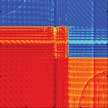 Valleytronics is an emerging field exploiting electron's valley degree of freedom for device applications. This novel concept is based on utilizing the wave quantum number of an electron in a crystalline material. One major challenge in valleytronic-based electronics is the lack of all-electrical-controlled valley filter, a device that produces valley-polarized current via electrical controlling knob and serves as a fundamental building block of valleytronics. Researchers now have proposed a versatile all-electric-controlled valley filter and demonstrate, for the first time, a concrete working design of valleytronic-based logic gate capable of performing all 16 types of Boolean logics.
Valleytronics is an emerging field exploiting electron's valley degree of freedom for device applications. This novel concept is based on utilizing the wave quantum number of an electron in a crystalline material. One major challenge in valleytronic-based electronics is the lack of all-electrical-controlled valley filter, a device that produces valley-polarized current via electrical controlling knob and serves as a fundamental building block of valleytronics. Researchers now have proposed a versatile all-electric-controlled valley filter and demonstrate, for the first time, a concrete working design of valleytronic-based logic gate capable of performing all 16 types of Boolean logics.
Dec 19th, 2017
 Researchers have discovered that ices of simple organic molecules such as alcohols and nonane (main component of diesel) can be nanopatterned by a focused electron beam. The entire 3D lithography process takes place in a single vacuum instrument and avoids exposing users to chemicals and the need for cleanrooms. With organic ice resist (OIR) technology, nanolithography can be made accessible to more scientists. The short-term implication of this work is to provide researchers with a new nanoscale 3D printing technology. The long-term implications might have a revolutionary impact on semiconductor production and computing.
Researchers have discovered that ices of simple organic molecules such as alcohols and nonane (main component of diesel) can be nanopatterned by a focused electron beam. The entire 3D lithography process takes place in a single vacuum instrument and avoids exposing users to chemicals and the need for cleanrooms. With organic ice resist (OIR) technology, nanolithography can be made accessible to more scientists. The short-term implication of this work is to provide researchers with a new nanoscale 3D printing technology. The long-term implications might have a revolutionary impact on semiconductor production and computing.
Dec 14th, 2017
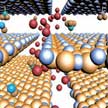 Motived by the large number of non-layered materials, e.g. transition metal oxides, which hold great promise in battery applications, scientists aim to extend the concept of nanofluidic channels into intrinsically non-layered materials and improve their electrochemical properties. In a new study, researchers have developed a Co3O4-based two-dimensional nano-architecture possessing nanofluidic channels with specially designed interlayer characteristics for fast lithium ion transport, leading to exceptional performance in lithium ion batteries ever reported for this material.
Motived by the large number of non-layered materials, e.g. transition metal oxides, which hold great promise in battery applications, scientists aim to extend the concept of nanofluidic channels into intrinsically non-layered materials and improve their electrochemical properties. In a new study, researchers have developed a Co3O4-based two-dimensional nano-architecture possessing nanofluidic channels with specially designed interlayer characteristics for fast lithium ion transport, leading to exceptional performance in lithium ion batteries ever reported for this material.
Dec 8th, 2017
 So far, most of the developed self-powered piezoelectric devices are rigid or have limited lateral stretchability and could not be used to harvest energy from lateral strain, which greatly limits their applications on large strain deformation. In new work, researchers have successfully fabricated a piezoelectric nanocomposite device with good transparency, high stretchability, and self-powered sensing characteristics. Attached to the human body, it can harvest biomechanical energy and monitor physiological signals.
So far, most of the developed self-powered piezoelectric devices are rigid or have limited lateral stretchability and could not be used to harvest energy from lateral strain, which greatly limits their applications on large strain deformation. In new work, researchers have successfully fabricated a piezoelectric nanocomposite device with good transparency, high stretchability, and self-powered sensing characteristics. Attached to the human body, it can harvest biomechanical energy and monitor physiological signals.
Dec 4th, 2017
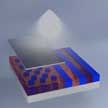 Block copolymer lithography is a cost-effective, parallel, and scalable nanolithography for the densely packed periodic arrays of nanoscale features, whose typical dimension scale is beyond the resolution limit of conventional photolithography. The directed self-assembly of block copolymers is one of the most promising techniques to enable the continued miniaturization of integrated circuits due to low cost, high speed, and simplicity of the process. Researchers have now designed for a novel block copolymer capable of easily changing its nanodomains at selective area and finally succeeded in development of dual nanopatterns.
Block copolymer lithography is a cost-effective, parallel, and scalable nanolithography for the densely packed periodic arrays of nanoscale features, whose typical dimension scale is beyond the resolution limit of conventional photolithography. The directed self-assembly of block copolymers is one of the most promising techniques to enable the continued miniaturization of integrated circuits due to low cost, high speed, and simplicity of the process. Researchers have now designed for a novel block copolymer capable of easily changing its nanodomains at selective area and finally succeeded in development of dual nanopatterns.
Nov 27th, 2017
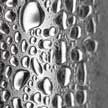 Liquid-impregnated coating technologies involve nanoscale texturing of a surface, which is then coated with a - usually lubricating - liquid. A lubricant infused surface is comprised of a textured solid surface into which a lubricating fluid is spontaneously wicked. Lubricant infused surfaces can exhibit excellent fluid repellency if designed properly. Scientists now have developed a model to determine which lubricant infused surfaces will work and which will fail based on material properties.
Liquid-impregnated coating technologies involve nanoscale texturing of a surface, which is then coated with a - usually lubricating - liquid. A lubricant infused surface is comprised of a textured solid surface into which a lubricating fluid is spontaneously wicked. Lubricant infused surfaces can exhibit excellent fluid repellency if designed properly. Scientists now have developed a model to determine which lubricant infused surfaces will work and which will fail based on material properties.
Nov 23rd, 2017
 Moderate exposure to sunlight has significant health benefits, however, exposure to ultraviolet (UV) radiation also is a major risk factor for most skin cancers. That means that, while moderate exposure to sunlight is recommended, there is a fine line to walk between beneficial and harmful amounts of UV exposure. To take the guesswork out of assessing the exposure to damaging UV rays, several wearable consumer UV sensors have already hit the market. Researchers have now proposed a simple and low-cost stick-on nanoplasmonic patch made of optically active silver nanoparticles embedded in a film of nanopaper. The patch changes color once it has been exposed to a certain amount of UV light.
Moderate exposure to sunlight has significant health benefits, however, exposure to ultraviolet (UV) radiation also is a major risk factor for most skin cancers. That means that, while moderate exposure to sunlight is recommended, there is a fine line to walk between beneficial and harmful amounts of UV exposure. To take the guesswork out of assessing the exposure to damaging UV rays, several wearable consumer UV sensors have already hit the market. Researchers have now proposed a simple and low-cost stick-on nanoplasmonic patch made of optically active silver nanoparticles embedded in a film of nanopaper. The patch changes color once it has been exposed to a certain amount of UV light.
Nov 22nd, 2017
 The detection of carbon monoxide (CO) in the air is a vital issue, as CO is a highly toxic gas and an environmental pollutant. Carbon monoxide is poisonous because it blocks the binding site for oxygen in hemoglobin. It is exactly this principle - a porphyrin ring with a central iron or cobalt atom that the poisonous gas attaches to - that can be used to implement sensors to warn against carbon monoxide. While carbon monoxide sensors have been extensively researched and commercialized, none make use of a molecule that can be voltage-activated using a newly reported method.
The detection of carbon monoxide (CO) in the air is a vital issue, as CO is a highly toxic gas and an environmental pollutant. Carbon monoxide is poisonous because it blocks the binding site for oxygen in hemoglobin. It is exactly this principle - a porphyrin ring with a central iron or cobalt atom that the poisonous gas attaches to - that can be used to implement sensors to warn against carbon monoxide. While carbon monoxide sensors have been extensively researched and commercialized, none make use of a molecule that can be voltage-activated using a newly reported method.
 Subscribe to our Nanotechnology Spotlight feed
Subscribe to our Nanotechnology Spotlight feed





